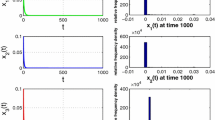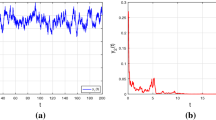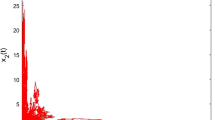Abstract
Stochastic competitive models with pollution and without pollution are proposed and studied. For the first system with pollution, sufficient criteria for extinction, nonpersistence in the mean, weak persistence in the mean, strong persistence in the mean, and stochastic permanence are established. The threshold between weak persistence in the mean and extinction for each population is obtained. It is found that stochastic disturbance is favorable for the survival of one species and is unfavorable for the survival of the other species. For the second system with pollution, sufficient conditions for extinction and weak persistence are obtained. For the model without pollution, a partial stochastic competitive exclusion principle is derived.
Similar content being viewed by others
References
Alonso, D., Pascual, M., & McKane, J. A. (2007). Stochastic Amplification in Epidemics. J. R. Soc. Interface, 4, 575–582.
Arnold, L. (1974). Stochastic differential equations: theory and applications. Wiley: New York.
Bahar, A., & Mao, X. (2004). Stochastic delay Lotka–Volterra model. J. Math. Anal. Appl., 292, 364–380.
Bandyopadhyay, M., & Chattopadhyay, J. (2005). Ratio-dependent predator-prey model: effect of environmental fluctuation and stability. Nonlinearity, 18, 913–936.
Beddington, J. R., & May, R. M. (1977). Harvesting natural populations in a randomly fluctuating environment. Science, 197, 463–465.
Braumann, C. A. (2002). Variable effort harvesting models in random environments: generalization to density-dependent noise intensities. Math. Biosci., 177& 178, 229–245.
Braumann, C. A. (2007). Itô versus Stratonovich calculus in random population growth. Math. Biosci., 206, 81–107.
Braumann, C. A. (2008). Growth and extinction of populations in randomly varying environments. Comput. Math. Appl., 56, 631–644.
Cattiaux, P. Méléard, S. (2009). Competitive or weak cooperative stochastic Lotka–Volterra systems conditioned on non-extinction. J. Math. Biol., doi: 10.1007/s00285-009-0285-4.
Chattopadhyay, J. (1996). Effect of toxic substances on a two species competitive system. Ecol. Model., 84, 287–289.
Du, N. H., & Sam, V. H. (2006). Dynamics of a stochastic Lotka–Volterra model perturbed by white noise. J. Math. Anal. Appl., 324, 82–97.
Freedman, H. I., & Shukla, J. B. (1991). Models for the effect of toxicant in single-species and predator-prey systems. J. Math. Biol., 30, 15–30.
Gard, T. C. (1984). Persistence in stochastic food web models. Bull. Math. Biol., 46, 357–370.
Gard, T. C. (1986). Stability for multispecies population models in random environments. Nonlinear Anal., 10, 1411–1419.
Gard, T. C. (1988). Introductions to stochastic differential equations. New York.
Gard, T. C. (1992). Stochastic models for toxicant-stressed populations. Bull. Math. Biol., 54, 827–837.
Gillespiea, D. T. (2000). The chemical Langevin equation. J. Chem. Phys., 113, 297–306.
Hallam, T. G., Clark, C. E., & Lassider, R. R. (1983a). Effects of toxicant on population: a qualitative approach I. Equilibrium environmental exposure. Ecol. Model., 8, 291–304.
Hallam, T. G., Clark, C. E., & Jordan, G. S. (1983b). Effects of toxicant on population: a qualitative approach II. First Order Kinetics. J. Math. Biol., 18, 25–37.
Hallam, T. G., & Deluna, J. L. (1984). Effects of toxicant on populations: a qualitative approach III. Environmental and food chain pathways. J. Theor. Biol., 109, 411–429.
Hallam, T. G., & Ma, Z. (1986). Persistence in population models with demographic fluctuations. J. Math. Biol., 24, 327–339.
Hallam, T. G., & Ma, Z. (1987). On density and extinction in continuous population model. J. Math. Biol., 25, 191–201.
Hardin, G. (1960). The competitive exclusion principle. Science, 131, 1292–1297.
He, J., & Wang, K. (2007). The survival analysis for a single-species population model in a polluted environment. Appl. Math. Model., 31, 2227–2238.
He, J., & Wang, K. (2009). The survival analysis for a population in a polluted environment. Nonlinear Anal. Real World Appl., 10, 1555–1571.
Higham, D. J. (2001). An algorithmic introduction to numerical simulation of stochastic differential equations. SIAM Rev., 43, 525–546.
Hsu, S. B., Luo, T. K., & Waltman, P. (1995). Competition between plasmid-bearing and plasmid-free organisms in a chemostat with an inhibitorm. J. Math. Biol., 34, 225–238.
Ikeda, N., & Watanabe, S. (1977). A comparison theorem for solutions of stochastic differential equations and its applications. Osaka J. Math. 619–633.
Jensen, A. L., & Marshall, J. S. (1982). Application of a surplus production model to assess environmental impacts on exploited populations of Daphnia pluex in the laboratory. Environ. Pollut., 28, 273–280.
Li, X., & Mao, X. (2009). Population dynamical behavior of non-autonomous Lotka–Volterra competitive system with random perturbation. Discrete Contin. Dyn. Syst., 24, 523–545.
Liu, H., & Ma, Z. (1991). The threshold of survival for system of two species in a polluted environment. J. Math. Biol., 30, 49–51.
Liu, M., & Wang, K. (2009). Survival analysis of stochastic single-species population models in polluted environments. Ecol. Model., 220, 1347–1357.
Liu, M., & Wang, K. (2010). Persistence and extinction of a stochastic single-specie model under regime switching in a polluted environment. J. Theor. Biol., 264, 934–944.
Ludwig, D. (1975). Persistence of dynamical systems under random perturbations. SIAM. Rev., 17, 605–640.
Luna, J. T., & Hallam, T. G. (1987). Effects of toxicants on population: a qualitative approach IV. Resources-consumer-toxicant models. Ecol. Model., 35, 249–273.
Luo, Q., & Mao, X. (2007). Stochastic population dynamics under regime switching. J. Math. Anal. Appl., 334, 69–84.
Ma, Z., Song, B., & Hallam, T. G. (1989). The threshold of survival for systems in a fluctuating environment. Bull. Math. Biol., 51, 311–323.
Mao, X., Marion, G., & Renshaw, E. (2002). Environmental Brownian noise suppresses explosions in populations dynamics. Stoch. Process. Appl., 97, 95–110.
Mao, X., Sabanis, S., & Renshaw, E. (2003). Asymptotic behaviour of the stochastic Lotka–Volterra model. J. Math. Anal. Appl., 287, 141–156.
Mao, X. (2005). Delay population dynamics and environmental noise. Stoch. Dyn., 5, 149–162.
Mao, X., & Yuan, C. (2006). Stochastic differential equations with Markovian switching. London: Imperial College Press.
May, R. M. (2001). Stability and complexity in model ecosystems. Princeton University Press: Princeton.
McKane, A. J., & Newman, T. J. (2005). Predator-prey cycles from resonant amplification of demographic stochasticity. Phys. Rev. Lett., 94, 218102.
Nelson, S. A. (1970). The problem of oil pollution of the sea. In Advances in marine biology (pp. 215–306). London: Academic Press.
Øsendal, B. (1998). Stochastic differential equations: an introduction with applications (5th ed.). Berlin: Springer.
Pang, S., Deng, F., & Mao, X. (2008). Asymptotic properties of stochastic population dynamics, Dynamics of Continuous. Dyn. Contin. Discrete Impuls. Syst. Ser. A Math. Anal., 15, 603–620.
Rudnicki, R., & Pichor, K. (2007). Influence of stochastic perturbation on prey-predator systems. Math. Biosci., 206, 108–119.
Samanta, G. P., & Maiti, A. (2004). Dynamical model of a single-species system in a polluted environment. J. Appl. Math. Comput., 16, 231–242.
Shukla, J. B., & Dubey, B. (1996). Simultaneous effect of two toxicants on biological species: a mathematical model. J. Biol. Syst., 4, 109–130.
Shukla, J. B., Freedman, H. I., Pal, V. N., Misra, O. P., Agarwal, M., & Shukla, A. (1989). Degradation and subsequent regeneration of a forestry resource: a mathematical model. Ecol. Model., 44, 219–229.
Thomas, D. M., Snell, T. W., & Joffer, S. M. (1996). A control problem in a polluted environment. Math. Biosci., 133, 139–163.
Turelli, M. (1977). Random environments and stochastic calculus. Theor. Pop. Biol., 12, 140–178.
Zhu, C., & Yin, G. (2009). On competitive Lotka–Volterra model in random environments. J. Math. Anal. Appl., 357, 154–170.
Author information
Authors and Affiliations
Corresponding author
Rights and permissions
About this article
Cite this article
Liu, M., Wang, K. & Wu, Q. Survival Analysis of Stochastic Competitive Models in a Polluted Environment and Stochastic Competitive Exclusion Principle. Bull Math Biol 73, 1969–2012 (2011). https://doi.org/10.1007/s11538-010-9569-5
Received:
Accepted:
Published:
Issue Date:
DOI: https://doi.org/10.1007/s11538-010-9569-5




